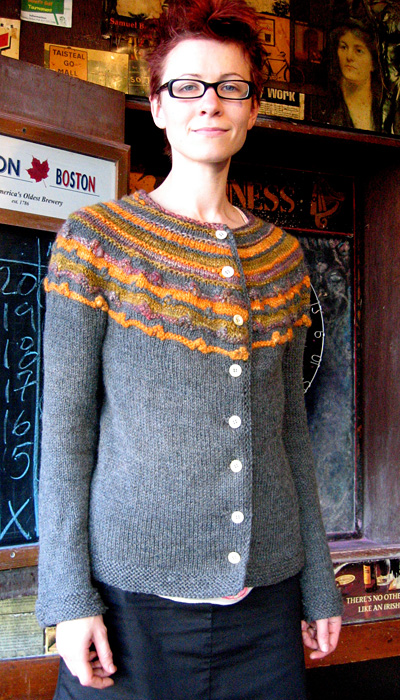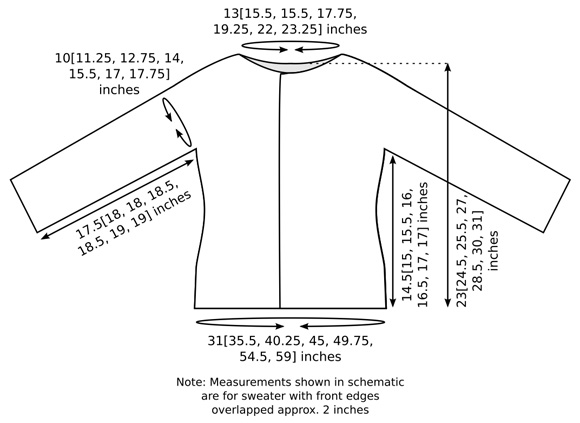
 |
|
|
 |
Weaverknits
I like to spin. Since getting a wheel a few years ago, I’ve managed to develop the skills necessary to create some neat barber-pole type 2-ply worsted and chunky weight yarns. I like them a lot. I like their thick-and-thin nature, and I even like the fact that, depending on the day, they may be a bit over- or under-twisted. Some day I might get pretty good at making other sorts of yarns, but I’m in no rush. Until that day, I’ve decided to celebrate my special yarns, with something larger than a hat or mittens...a sweater of confidence! King of Confidence allows spinners of all levels to incorporate spinning into a gorgeous garment designed to be forgiving to your yarn’s special traits. The body of the sweater is worked in a worsted-weight commercial yarn, and the piece is worked in one piece from the bottom up, with sleeves and body joined at the yoke. In the case of the sample, the handspun yarns were chunkier than the worsted weight Main Color (coming in at 10 WPI as opposed to 13 WPI for the Cascade 220). |
When spinning, aim for a weight close to the weight of your MC, and be sure to swatch a few stripes or a repeat or two of the yoke pattern, alternating MC and handspun yarns, and steam block it well before beginning your project to make sure your yarns are compatible. So have confidence in your yarn, or support handspinners who
sell their products. Three 4 oz. skeins of worsted to
chunky weight handspun purchased from a spinner is a relatively
economic way to use luxury yarns in a cardigan! |
|
|
|
|
|
SIZE |
|
FINISHED MEASUREMENTS |
|
MATERIALs Commercial Yarn Finished Yarn: Drafting Method:
Tools |
|||||
|
GAUGE |
|
PATTERN NOTES |
|
For sizes L, 1X, 2X and 3X, front of sweater will be approx. 1 inch wider than back when buttoned. This is done to give slightly more ease over the bust. Working wraps together with wrapped
sts on RS rows: Working wraps together with wrapped
sts on WS rows: |
|
DIRECTIONS  Using long circular needle and MC, CO 140[160, 180, 200, 220, 240, 260] sts. Work 12 rows in garter st (k all sts). Next Row [RS]: K37[42, 47, 53, 58, 63, 68], place marker, k66[76, 86, 94, 104, 114, 124], place marker, k37[42, 47, 53, 58, 63, 68]. Work in stockinette st until work measures 2.75[2.5, 3.5, 3.25, 3, 4.5, 3.75] inches, ending with a WS row. Buttonhole Row 1 [RS]: K3, BO 2 sts, k to end. Continue in stockinette st until work measures 5.5[6, 6, 6.5, 6.5, 7, 7] inches, ending with a WS row. Shape Waist: Waist Increase Row [RS]: K to 1 st before marker,
m1, k1, slip marker, m1, k to next marker, m1, slip
marker, k1, m1, k to end. Continue in stockinette st until work measures 14.5[15,
15.5, 16, 16.5, 17, 17] inches or
desired length to underarm, ending
with a RS row.
 Using double-point needles (or 16-inch circular needle), CO 42[48, 54, 60, 66, 72, 76] sts. If using double-point needle, divide sts between needles. Place marker and join to begin working in the round, being careful not to twist. Round 1: K all sts. Round 2: P all sts. Repeat these 2 rounds 5 times more for garter st cuff. Work in stockinette st until sleeve measures 17.5[18, 18, 18.5, 18.5, 19, 19] inches or desired length to underarm, ending last round 4[4, 5, 5, 6, 6, 7] sts before marker. BO next 8[8, 10, 10, 12, 12, 14] sts, removing marker. Break yarn and place remaining 34[40, 44, 50, 54, 60, 62] sts on spare needle(s). Make second sleeve in the same way, but do not remove sts from needles. YOKE Joining Row: Using long circular needle and yarn attached to lower body, k 33[38, 42, 48, 52, 57, 61] sts of right front, k 34[40, 44, 50, 54, 60, 62] sts of one sleeve, k 58[68, 76, 84, 92, 102, 110] sts of back, k 34[40, 44, 50, 54, 60, 62] sts of other sleeve, k 33[38, 42, 48, 52, 57, 61] sts of left front. 192[224, 248, 280, 304, 336, 356] sts on needle. Sizes XS, S, 1X Only: Sizes M, 2X, 3X Only: Work in stockinette st until yoke measures 1[1, 1, 1.5, 2, 2.5, 3.5] inches from Joining Row, ending with a WS row. Note: As you work yoke pattern below, if Buttonhole
Row 1 will fall anywhere between Rows 1-6 of Textured
Yoke Pattern, work first 10 sts of
RS rows and last 10 sts of WS rows as follows: If desired, place st markers between repeats of pattern. Number of sts in each repeat will increase from 10 sts to 16 sts on Row 1, then will be decreased back to 10 over the following rows. This will happen again on Row 7.

Row 1 [RS]: Using CC1, [k2, (k1, yo, k1, yo, k1, yo, k1] in next st (1 st increased to 7 sts), k7] to end. Row 2 [WS]: Using CC1, k all sts. Row 3 [RS]: Using MC, [k1, k2tog, k5, ssk, k6] to end. Row 4 [WS]: Using MC, [p6, p2tog tbl, p1, sl 1 with yarn held to front of work, p1, p2tog, p1] to end. Row 5 [RS]: Using MC, [k1, k2tog, sl 1 with yarn held to back of work, ssk, k6. Row 6 [WS]: Using MC, p all sts. Row 7 [RS]: Using CC2, [k7, (k1, yo, k1, yo, k1, yo, k1] in next st (1 st increased to 7 sts), k2] to end. Row 8 [WS]: Using CC2, k all sts. Row 9 [RS]: Using CC3, [k6, k2tog, k5, ssk, k1] to end. Row 10 [WS]: Using CC3, [p1, p2tog tbl, p1, sl 1 with yarn held to front of work, p1, p2tog, p6] to end. Row 11 [RS]: Using CC3, [k6, k2tog, sl 1 with yarn held to back of work, ssk, k1. Row 12 [WS]: Using CC3, p all sts. Rows 13-14: Using MC, work as for Rows 1-2. Rows 15-18: Using CC1, work as for Rows 3-6. Rows 19-20: Work as for Rows 7-8, again using CC2. Rows 21-23: Using MC, work as for Rows 9-11. If you were using st markers, remove them now. First Yoke Decrease Row [WS]: Using MC, [p1, p2tog] to last 1[1, 1, 1, 0, 1, 0] sts, p1[1, 1, 1, 0, 1, 0]. 127[147, 167, 187, 200, 227, 240] sts. Yoke Stripe Pattern: Size XS Only: Sizes S, M, L, 1X, 2X, 3X Only: Rows 19-20: Using CC2, k all sts. Sizes S, M, L Only: Sizes 1X, 2X, 3X Only: Neck Shaping: Rows 1-2: Using CC3, k all sts. Sizes XS, S Only: Sizes M, L, 1X, 2X, 3X Only: All Sizes: When working following rows, pick up wraps and work them together with wrapped sts (see Pattern Notes). In next row, CC1 will be joined at beginning of short row (not at edge of sweater). Row 7 [RS]: Using CC1, k to wrapped st, k2, W&T. For sizes M, L, 2X and 3X, work 2 more rows in stockinette st. For all sizes, loosely BO all sts. |

|
|
FINISHING Sew sleeves to bdy along BO edges at underarms. Weave in ends. Steam or wet block cardigan. Use sewing thread to sew buttons to cardigan opposite buttonholes, with fronts overlapped approx. 2 inches. |
| ABOUT THE DESIGNER |
|
|
|
Pattern & images © 2009 Weaverknits. Contact Weaverknits |